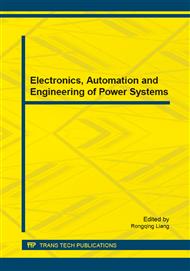[1]
M. Popov, L. Sluis, R.P.P. Smeets, J. Lopez-Roldan and V.V. Terzija. Modelling, Simulation and Measurement of Fast Transients in Transformer Windings with Consideration of Frequency-Dependent Losses, " Electric Power Applications, IET, vol. 1, no. 1, pp.29-35, (2007).
DOI: 10.1049/iet-epa:20060124
Google Scholar
[2]
G.B. Gharehpetian, H. Mohseni and K. Moller. Hybrid Modelling of Inhomogeneous Transformer Winding for Very Fast Transient Overvoltage Studies. IEEE Trans. Power Delivery, vol. 13, no. 1, pp.157-163, (1998).
DOI: 10.1109/61.660873
Google Scholar
[3]
B. Gustavsen. Application of vector fitting to high frequency transformer modeling. in Proc. International Conference on Power System Transients, IPST'2003, New Orleans, paper 9d-2, (2003).
Google Scholar
[4]
P. Feldmann and R. Freund. Efficient Linear Circuit Analysis by Padé Approximation via the Lanczos Process. IEEE Trans. Comput. –Aided Design Integr. Circuit Syst., vol. 14, no. 5, pp.639-649, (1995).
DOI: 10.1109/43.384428
Google Scholar
[5]
R. Freund. SPRIM: Structure-Preserving Reduced-Order Interconnect Macromodeling. in Proc. Tech. Dig. IEEE/ACM Int. Conf. Comput. -Aided Design, pp.80-87, (2004).
DOI: 10.1109/iccad.2004.1382547
Google Scholar
[6]
S. Gugercin and A. Antoulas. A Survey of Model Reduction by Balanced Truncation and some new Results. Int. J. Control, vol. 77, no. 8, pp.748-766, (2004).
DOI: 10.1080/00207170410001713448
Google Scholar
[7]
T. Reis and T. Stykel. Positive Real and Bounded real Balancing for Model Reduction of Descriptor Systems. Int. J. Control, vol. 83, no. 1, pp.74-88, (2010).
DOI: 10.1080/00207170903100214
Google Scholar
[8]
Q. Cao, H. Zhang and Y. Sun. A Revised Minimum Information Loss Method for Discrete-time Model Reduction. The Sixth World Congress on Intelligent Control and Automation, WCICA 2006., vol. 1, pp.1456-1460, (2006).
DOI: 10.1109/wcica.2006.1712590
Google Scholar
[9]
B. Gustavsen and A. Semlyen. Rational Approximation of Frequency Domain Responses by Vector Fitting. IEEE Trans. Power Delivery, vol. 14, no. 3, pp.1052-1061, (1999).
DOI: 10.1109/61.772353
Google Scholar
[10]
A. Ubolli and B. Gustavsen. Comparison of Methods for Rational Approximation of Simulated Time-Domain Responses: ARMA, ZD-VF, and TD-VF. IEEE Trans. Power Delivery, vol. 26, no. 1, pp.279-288, (2011).
DOI: 10.1109/tpwrd.2010.2080361
Google Scholar


